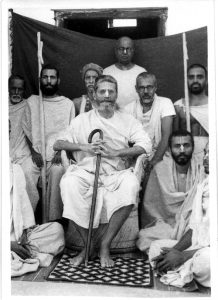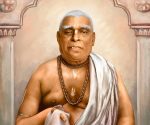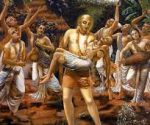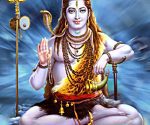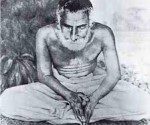He Kept His Life In His Hands
(VNN) Srimad Bhaktivedanta Narayana Gosvami Maharaja
[This year, 2014, October 8th (in India) is the disappearance day of Srila Bhakti Prajnana Kesava Gosvami Maharaja, the initiating and sannyasa guru of Srila Bhaktivedanta Narayana Gosvami Maharaja and the god-brother and sannyasa guru of Srila Bhaktivedanta Swami Maharaja.
In honor of this most auspicious day, please accept this lecture spoken by Srila Narayana Maharaja in Murwillumbah, Australia, February 9, 2004:]
Today is a very auspicious day. It is the birthday of my spiritual master, om visnupada Sri Srimad Bhakti Prajnana Kesava Gosvami Maharaja.
I have seen with my own eyes how he used to observe Vyasa-puja on his birthday, by offering respects to all other Vaisnavas – especially to senior Vaisnavas, but also to juniors.
The backbone of bhakti is guru-nistha (strong faith in one’s spiritual master), and those who have no guru-nistha can never develop in Krsna consciousness. We have seen his guru-nistha. He wanted to glorify his Gurudeva, Srila Bhaktisiddhanta Sarasvati Thakura Prabhupada, but he became overwhelmed simply by beginning to utter the word ‘Prabhupada’. He would begin to weep loudly, and then he would call upon us (Srila Vamana Maharaja, Srila Trivikrama Maharaja, myself and others) by some signal to glorify his Gurudeva. Having heard from him about his relationship with his Gurudeva, we glorify him in connection with his absorption in his Gurudeva’s service.
This is also the way in which we glorify Lord Krsna. What is the glorification of Krsna? It is the glorification of His associates – especially the gopis, and especially Srimati Radhika. If one glorifies Srimati Radhika, Krsna is automatically glorified. Similarly, if Parama-gurudeva (Srila Sarasvati Thakura Prabhupada) is glorified, the glory of our Gurudeva will come; it is bound to come.
It may be that the liberated guru is not liberated in the eyes of his god-brothers, but in the eyes of the disciple he is the direct representative of Sri Krsna Himself. The disciple will always have strong faith that, “My Gurudeva is a special representation or manifestation of Krsna. We have heard everything from him.”
What is the symptom of a disciple who has guru-nistha? He will give proper respect even to a dog that is related to his Guru. If he does not give proper respect to everyone related to his guru, whether they are initiated or not, if he has no regard and honor for them, then his honor for his guru is actually only a show. He has no real guru-nistha.
I have seen how my Gurudeva served the mission and mood of his Gurudeva. This service is called guru mano-bhista seva.
sri caitanya-mano bhistam sthapitam yena bhutale
svayam rupa kada mahyam dadati sva-padantikam
[“When will Sri Rupa Gosvami give me the shelter of his lotus feet? Because he understood the innermost desire of Sri Caitanya Mahaprabhu, he was able to establish His mission in this world and is very dear to the Lord.” (Sri Prema-bhakti-candrika, by Narottama dasa Thakura)]
Always have this kind of nistha towards your spiritual diksa-guru and siksa-guru. The diksa-guru may also be siksa-guru. If your diksa and siksa-guru are the same personality, this is very good. In some cases a separate siksa-guru is needed, as the disciple cannot always reveal his thoughts to the diksa-guru because of a mood of great awe and reverence (sambhrama-bhava). With the siksa-guru there is visrambha-bhava (a mood of intimacy). In visrambha-bhava, the disciple may even quarrel with Gurudeva – for Gurudeva, for his service. Sometimes we used to quarrel with our Gurudeva, for his service, and this is a symptom of guru-nistha. Another symptom is always offering respect to superiors – especially to god-brothers. Nowadays, I see that god-brothers quarrel with each other. They do not want to be together to glorify their Guru.
Gurudeva used to observe Vyasa-puja according to the book discovered by Srila Bhaktisiddhanta Sarasvati Thakura Prabhupada and edited by Srila Bhaktivinoda Thakura. In that book there is an explanation of the seven groups with five personalities in each group (the seven pancakas), to be worshiped by the acarya on his birthday.
These seven groups are guru-parampara-pancaka (guru, parama-guru, paratpara-guru, paramesthi-guru, and param-paramesthi guru), krsna-pancaka (Sri Krsna, Vasudeva, Sankarsana, Pradyumna, Aniruddha.), sanakadi-pancaka (Four Kumaras and Visvaksena), vyasa-pancaka (Srila Vyasadeva, Jaimini Rsi, Paila Rsi, Vaisampayana Rsi, Sumantu Rsi), Vaiyasaki-pancaka (Sukadeva Gosvami and the four sampradaya acaryas.), panca-tattva pancaka (Sri Caitanya Mahaprabhu, Sri Nityananda Prabhu, Sri Advaita Acarya, Sri Gadadhara Pandita, and Srivasa Pandita) and upasya-pancaka (Radha-Krsna, Gaura Gadadhara, Guru).
We should try to have regard for all acaryas of the four sampradayas, the four guru-paramparas: Ramanuja, Madhvacarya, Visnusvami, Nimbaditya, and the four Kumaras (Sanaka, Sanatana, Sanat-kumara and Sanandana). We should have regard for Sri Panca-tattva, and especially for Sri Gaura-Gadadhara, Sri Sri Radha-Krsna and Sri Gurudeva. Try to follow all the details of this worship.
Gurudeva used to say, “On my birthday I should give proper honor to all guru-parampara acaryas, god-brothers, and all senior Vaisnavas.” What I have and what I am preaching is not coming from me. It is not that I am so intelligent or that I am preaching – the credit belongs to my Gurudeva. By the mercy of my Gurudeva I know the mercy of Sri Caitanya Mahaprabhu, Sri Rupa-Sanatana, Sri Rupa-Raghunatha and other guru-parampara acaryas. I was sinking in the well of worldly activities in material existence, but he took my sikha and dragged me, and he mercifully engaged me in his service – fully, not partly. He did not tell me, “You should be a householder.” He dragged me and engaged me. Sometimes desires outside the realm of pure devotion came in my mind, and I asked him, “How can I be saved?” He answered, “Don’t worry; I will save you. If one is sincere, Guru and Krsna mercifully save him. So don’t worry.”
When he would perform his Vyasa-puja, he would first worship his Gurudeva, and then he would give proper honor to all Vaisnavas and especially seniors. During his manifest presence there were no seniors, because he was the senior-most. He joined the movement of Srila Prabhupada and became a disciple in 1916, so he was senior to others. Only five or six had joined before him, like Narahari prabhu, Bhakti-vilasa Tirtha Maharaja and a few others like the brother of Vasudeva, Bhaktipradipa Tirtha Maharaja. At that time, when Prabhupada Bhaktisiddhanta Sarasvati Thakura would do arati, my Guru-Maharaja would ring the bell and Narahari prabhu was also there.
At that time there was no Sri Caitanya Matha. Instead there were many Muslim graves and Muslim influences.*[See Endnote 1] My Guru-Maharaja came in the night, took out all the graves and threw them away. On that same night he planted a large garden of mango trees and flowers. On the next morning, when the Muslims came to do their Namaz, they exclaimed, “Oh, Where is our place?”
Srila Sarasvati Thakura Prabhupada was very happy because Guru Maharaja used to give his life and soul to fulfill Prabhupada’s desires, which is very difficult for most disciples to do. Sometimes a disciple does not obey his guru. Guru says, “Don’t do this,” for the betterment of that very fellow, and yet that disciple rejects his guru’s order. This is not a symptom of guru-nistha. We should give our life to serve his every word. Our Gurudeva always used to ‘keep his life in his hands’ (a Hindi expression meaning ‘to be prepared to give one’s life’) for the purpose of Srila Prabhupada. He even went to jail for him.
Once a person tried to defame Prabhupada *[See Endnote 2] by writing, “He is a tattva-jnani (knower of philosophy) and not a rasika-bhakta (knower of Krsna’s sweet pastimes). He does not know the taste of mango; he simply sucks the seed. As there is no taste in a seed, concentrating on philosophy without absorption in Krsna’s confidential pastimes is tasteless. He is like that, so he is a tattva-jnani. He does not know Sri Rupa-Raghunatha’s line and he does not know the krsna-prema of the gopis. He writes about tattva-jnana, and he is preaching that everywhere”.
They were blind. They never actually saw him. By what his disciple, my Gurudeva, preached to me and others, you can realize his position. He preached under the cover of tattva-jnana. He did not expose the confidential secrets of Krsna’s pastimes and the philosophy behind them. He preached this to qualified persons, and he kept the highest truths of Krsna consciousness covered from others.
My Gurudeva wrote against those persons, and for that reason they filed a court case against him. They managed to get big, qualified advocates to plea that Guru Maharaja should be put in jail. Our Gurudeva then engaged an advocate from the high court in Calcutta, and those persons were obliged to apologize.
By the grace of our Gurudeva, when I was in Mathura, I was the editor, writer, translator, and manager for his monthly magazine called Bhagavat-patrika. I published it alone. I used to translate Srila Prabhupada’s articles, Gurudeva’s articles, Srila Bhaktivinoda Thakura’s articles, and other articles.
Someone once wrote in a publication of the Nimbarka sampradaya*[See Endnote 3] that when Sri Caitanya Mahaprabhu met with Kesava Kasmiri, Kesava Kasmiri defeated Him and gave Him the gopala-mantra. Sriman Mahaprabhu was thus the disciple of Kesava Kasmiri.
This publication came to me and I showed it to my Gurudeva. His face at once became red, he became angry and he ordered me to get a piece of paper. He then dictated to me that there was no Nimbarka in our history, and no books of Nimbarka. He said that Srila Jiva Gosvami and our other Gosvamis, Sri Madhavacarya, Sri Ramanuja, Srila Gopal Bhatta Gosvami and all other previous acaryas never wrote about anyone named Nimbarka acarya. The followers of this false person used to say that Nimbarka Acarya lived at the time of Krsna. If that were true, why have none of the acaryas written about him? Sankaracarya never wrote about him and Srila Jiva Gosvami never wrote about him in his Sandarbhas. Thus there was no person named Nimbarka – this false person’s followers had invented a story.
Guru Maharaja explained from the evidence in Sri Caitanya-caritamrta that Kesava Kasmiri came to Navadvipa and was defeated by Sri Caitanya Mahaprabhu, and then he received some teaching from the Lord. Gurudeva wrote: “The mentality ‘I will conquer the whole world’ is not the teaching of vidya, knowledge.” Our paper was sent to those persons involved in writing the misinformed article, after which they became quite furious. “Oh, there is no Nimbarka?!” They challenged, and they filed a case in court for defamation. Our Guru Maharaja replied, “I will prove my statements, so you should file a suit for one million rupees for defamation. You should go to court, and I am also coming. I am ready and will prove my points.” He proved all his points and the opponents apologized. They promised, “In the future we will never write like this.”
If one wants to have guru-nistha, he should read my Guru Maharaja’s biography and philosophy. This book has been appreciated all over the world. In this biography I have tried to bring all the teachings of our acaryas. If you read it, you will be able to understand what is guru-nistha and what was the greatness of my Guru Maharaja. Parama-pujyapada Srila Bhaktivedanta Svami Maharaja did not take sannyasa from him as a formality. He knew all the principles and philosophy of pure devotional service. Since the time he joined the temple he had so much honor for Guru Maharaja, for he saw what he was doing for Prabhupada. He did not take sannyasa from him accidentally or to complete a formality.
Our Guru Maharaja took sannyasa from Parama-pujyapada Srila Sridhara Maharaja. Even though Srila Sridhara Maharaja joined the mission of their Gurudeva after him, he was an elevated philosopher, a knower of the established truths of bhakti, and his very name, Bhakti Raksaka, means “protector of devotion”. He has also extensively glorified our Gurudeva. To teach other devotees, they used to hold meetings and defeat each other’s arguments in philosophy. Parama-pujapada Srila Sridhara Maharaja would establish one thing and Guru Maharaja would defeat all his arguments, and then at the next moment Srila Sridhara Maharaja would defeat all the arguments of our Gurudeva. The entire audience would hear them, enjoy their discussions, and in this way learn so much philosophy.
All the sannyasis of Srila Prabhupada Bhaktisiddhanta Sarasvati Thakura had great regard for our Gurudeva. When Srila Sridhara Maharaja came to Mayapura for the first time, his name was Ramananda Brahmacari. He saw a young boy of about twenty years old sitting on a chair under the shade of a jackfruit tree and keeping his feet on the table and hands joined together. Srila Sridhara Maharaja saw from a distance that the young brahmacari was wearing white cloth, not saffron cloth, and he was sitting in a very relaxed manner. At that time senior and very qualified sannyasis would come and offer him their obeisances, and they would ask him questions. Staying in the same position, not getting up to offer them obeisances, he would answer. Then, again offering him their obeisances, they would leave.
Pujyapada Srila Sridhara Maharaja told this story to me personally. He told me that he asked the devotees present there at that time, “Who is this young boy in white dress, to whom even sannyasis in saffron cloth are offering obeisances? Who is it that, in the same position, is answering their questions and they are leaving very satisfied?” Someone replied, “He is Vinoda-babu. He managed the complete Mayapura premises, and now there is no longer any influence of Muslims.” If you want to know more, you can read his biography and learn what an influential and great acarya he was.
At the time of parikrama, I saw that when an editorial article was needed, Parama-pujyapada Srila Vamana Maharaja would wait with paper and pen – to know what Guru Maharaja wanted to write. Guru Maharaja would be surrounded by thousands of persons at that time, so at the same time he would dictate the required article and also talk with those persons.
If we would write any article, we would have to look at so many books for reference, and we would have to carefully think and consider. But Guru Maharaja had no need to think. Although continually interrupted by others, he would speak and Srila Vamana Maharaja, who was qualified like Srila Vyasadeva’s divine scribe Ganesha, would take the dictation.
Read the biography and learn how to respect others and obey the bona fide and transcendental Gurudeva. Don’t wonder, “Is what my Gurudeva telling wrong or right?” You may test him before the time of initiation, not after. If he says, “Jump in the ocean” and you can do so, that is good. We have seen so many qualified devotees like Ananta Vasudeva and Sundarananda Vinoda prabhu who were vastly learned; but they left their Gurudeva, Srila Prabhupada Bhaktisiddhanta Sarasvati Thakura, because they were thinking, “Is what he is telling right or not?” They thought that he was not qualified for raganuga-bhajana and thus offended him. They took poison and went to hell, and one of them literally took poison.
Try to think about these activities of my Guru Maharaja and be a disciple like him. If Gurudeva tells his disciple to give his life and soul to him, he should do that at once – like Hanuman, who gave himself for the service of Sri Ramacandra. The disciple thinks that Gurudeva should not tell him to do this, however. He does not understand that whatever Gurudeva says is for his benefit.
So today is his birthday and we are going to celebrate Vyasa-puja – guru-puja. We will do so in the way that was introduced in our sampradaya by Sri Nityananda Prabhu and Sri Caitanya Mahaprabhu.
Gaura premanande
[The following is from the book “Acarya Kesari Sri Srimad Bhaktiprajnana Kesava Gosvami – His Life and Teachings” by Tridandisvami Sri Srimad Bhaktivedanta Narayana Maharaja:
Endnote 1 – “After Sri Caitanya Mahaprabhu entered aprakata-lila and His lilas became unmanifest, the Bhagavati Ganga changed course many times. Places that had once been in Mayapura were relocated to the relatively high ground of the west bank. The extensive town of Nadiya (Navadvipa), which had previously been on the east bank, became situated on the Ganga’s west bank, and the east bank became a deserted, desolate place. During the reign of the yavanas (Muslims), all the sacred places of the Hindus were destroyed, temples were demolished and the names of the places of Mahaprabhu’s pastimes were changed. The temples at the birthplaces of Sri Rama in Ayodhya and Sri Krsna in Mathura were razed, and mosques were erected on their foundations. Their names were changed to Phaijabad and Mominabad. Similarly, the Muslims changed the name of Sriman Mahaprabhu’s birthplace from Mayapura to Miyampur. Later, Srila Bhaktivinoda Thakura discovered Jagannatha Misra Bhavan, the birthplace of Sri Gaura, and again called it Sridhama Mayapura. In this way the name Sridhama Mayapura once more became known to the world.
“Besides changing the name of Sridhama Mayapura, the Muslims had also made a graveyard on the huge courtyard of Candrasekhara Bhavan, which was very close to Jagannatha Misra Bhavan, and this was still there when Sri Vinodabihari became manager of Sri Caitanya Matha. He could not tolerate this atrocity and acted fearlessly and boldly. One night, while all were asleep, he had all the graves in the graveyard dug up and placed elsewhere. In their place he had large, beautiful trees and foliage planted and overnight he made a beautiful park with a wall all around it for protection. The next morning everyone was astounded at what had taken place. The local Muslims reported it to the police and filed a case in court. But police officials and governmental investigators could not find any trace of the graveyard; they saw only an old garden. In this way the devotees reclaimed Candrasekhara Bhavan and no one was able to stop them. For this pious act the name of Sri Vinodabihari Brahmacari will be written in golden letters in the history of India.”
[Endnote 2 – “On another occasion, members of the sahajiya-sampradaya of Bengal wrote essays full of apasiddhanta, opposing Srila Bhaktisiddhanta. Srila Gurudeva argued with them in a similar way, using abrasive words. The opposition party actually presented a lawsuit in court against Srila Gurudeva and other devotees, including the editor of Sri Gaudiya Patrika. However, when they were faced with Srila Gurudeva’s train of thought, they also had to bow their heads in defeat. They begged him for forgiveness in the court of law and thereafter avoided him. For these reasons, Om Visnupada Sri Srimad Bhaktisaranga Gosvami Maharaja, who was Srila Gurudeva’s dear Godbrother and a leader of the Gaudiya community, decorated Srila Gurupadapadma with the title ‘Pasanda-Gajaikasimha,’ the lion who vanquishes the elephants of heresy.’]
[Endnote 3 – “Some time in 1956, Srila Gurudeva came to Mathura to see Kesavaji Gaudiya Matha. At that time followers of the Nimbarka sampradaya in Vrndavana used to publish a spiritual journal called Sri Sudarsana. In one issue they cast aspersions on Sri Caitanya Mahaprabhu, saying that He was a disciple of Kesava Kasmiri. In other editions they insolently dared to claim that Gaudiya Vaisnava acaryas such as Srila Visvanatha Cakravarti Thakura were in the Nimbarka sampradaya. When I showed these editions to Srila Gurudeva, he became extremely angry and immediately had a short essay written for Sri Bhagavata Patrika. The headline was ‘Sri Nimbaditya and Nimbarka are not the same person.’ The purport of his headline is as follows.
“‘Nowhere in the scriptures is there any mention of a Nimbarka sampradaya. The Puranas mention a vaisnava-acarya called Sri Nimbaditya, and the Catuhsana (the four Kumaras) have accepted this Nimbaditya Acarya as their sampradaya-acarya in the age of Kali. However, Nimbarka Svami is a completely different person. Nimbaditya was a disciple of Naradaji at the end of Dvapara-yuga, but Nimbarka Acarya appeared much more recently. Great and eminent authors of scripture such as Srila Jiva Gosvami have mentioned the names of the prominent acaryas of all the other sampradayas, but they have not mentioned the name of Nimbarka Acarya anywhere.
“‘The Nimbarka sampradaya currently uses the Parijata-bhasya which was written, not by Nimbaditya Acarya, but rather by Srinivasa Acarya and Kesava Kasmiri. These two wrote this scripture and then preached that it had been written by their guru. The scriptures of the Six Gosvamis mention the names of acaryas such as Sri Ramanuja, Sri Madhva, Sri Visnu Svami, Sri Nimbaditya and Sri Vallabha Acarya. If the Nimbarka sampradaya had existed even to a slight extent at that time, then they would most certainly have mentioned the name of Nimbarka Acarya as well. None of the other sampradaya acaryas, such as Sri Ramanuja, Sri Madhva, Sri Visnu Svami and so on have mentioned Nimbarka Acarya’s name in any of the scriptures that they have written.’
“When this essay was published in Sri Bhagavata Patrika, the office directors of the Sudarsana journal announced that they were making arrangements to prosecute for slander. Srila Gurudeva replied firmly, “We will prove each and every word that we have written on the basis of evidence supported by sastra.” When the prosecution party heard about Srila Gurudeva’s immense scriptural knowledge and his profound personality, they became absolutely silent, and from that day onwards they did not dare to write any more nonsense.]




